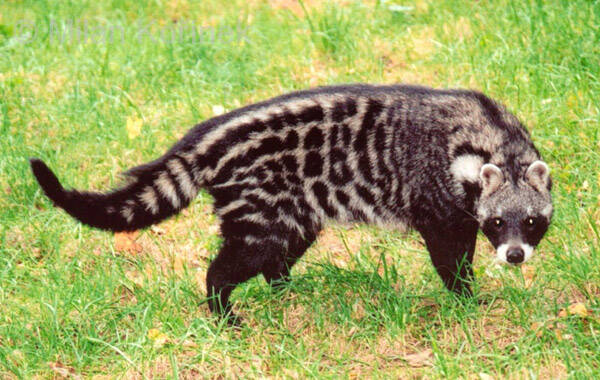Civettictis civetta
IUCN
LCBasic Information
Scientific classification
- name:Civettictis civetta
- Scientific Name:Civettictis civetta
- Outline:Carnivora
- Family:Schizopoda Viverrinae A.Viverrinae
Vital signs
- length:70-84cm
- Weight:7-20kg
- lifetime:10-15years
Feature
Unlike other civets, it is not cat-like, but rather more like a short dog.
Distribution and Habitat
African civets are found in most of sub-Saharan Africa and Botswana, Namibia and South Africa. They live in forests, including dense rainforests or semi-forested areas.
Appearance
They have rough fur with black and white spots, white faces, black eye spots and light muzzles. They have glands around their anus that secrete civetone to mark territory and can also be used to make perfume.
Details
The African civet (scientific name: Civettictis civetta) is a civet in tropical Africa.

The African civet is the largest representative of the African civet family. It is the only member of its genus. African civets are found in sub-Saharan Africa and most of Botswana, Namibia and South Africa. They inhabit forests, including dense rainforests or semi-woodlands. Although they often fall into jackal traps or die in traffic accidents, they are not Near Threatened. They are nocturnal animals, especially active at night, and can be found in a wide range of habitats, from dense forests to open fields.
The African civet is a unique mammal that is easily identifiable because of its unique coat color; their entire bodies are covered with coarse hair with black and white stripes and spots, which is rich in variety and mysterious. The black bands around its eyes make the African civet's eyes resemble those of a raccoon. Other notable features are its disproportionately large hind limbs and an upright dorsal crest.
African civets are omnivores and will eat small vertebrates, invertebrates, eggs, carrion and plants. They can eat venomous invertebrates (such as millipedes, animals that most species avoid) and snakes, and can handle larger prey such as mongooses and hares. They mostly forage alone. When hunting, they first detect prey through smell and hearing, rather than sight.
Like all civets, African civets have perineal glands, or "scent glands," which secrete a liquid called "civet scent" or "civet scent" that spreads over the territory to mark the size of its territory. . Humans extract civet scent as an important raw material for the spice industry.
Some civets, such as the African civet and the Congolese water civet, are semi-aquatic. Although most civets live on the ground, civets can also be found in trees eating fruit.
Listed in the "World Conservation Union Red List of Threatened Species" (IUCN) 2015 ver 3.1 - Least Concern (LC).
Listed in Appendix III of the 2019 version of the Convention on International Trade in Endangered Species of Wild Fauna and Flora (CITES) Appendix I, Appendix II and Appendix III.
Protect wild animals and eliminate wild game.
Maintaining ecological balance is everyone’s responsibility!








